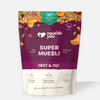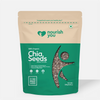
(Indian) Vegan Foods Loaded in Iron
Iron is an essential mineral that contributes to good health and overall function. Without it, our bodies couldn’t form hemoglobin, a protein in the red blood cells that transports oxygen all throughout the body.
One common misconception about veganism is that you'll be deficient in iron. On the contrary, a properly planned plant-based diet contains more than enough iron for the body’s needs and more!
But iron deficiency anemia is real. In fact, it’s the most common nutritional disorder in the world! And in India, it impacts over 600 million people. The real world impact of iron deficiencies can be devastating, but there are solutions.
One of the best ways to address this issue and help people get enough iron is through education. Not all foods are the same, but knowing how to make better choice makes a difference.
Read on to learn about iron and the best plant-based sources of iron in India!
Heme iron and non-heme iron
There are two forms of iron found in food: heme and non-heme. Heme iron is found in animal based foods like meat, eggs, poultry, and dairy. When a person eats heme iron, anywhere between 15 and 35 percent is absorbed by the body.
The other form is non-heme iron, which is found in plant-based foods like fruits, vegetables, legumes, and so on. This type is less bioavailable, and only 2-20% is absorbed by the body.
The implications of this are pretty clear. If you are a vegan or vegetarian, you need to consume more iron to maintain the same levels in the body. The good news is that vegan and vegetarian diets contain higher levels of vitamin C, which significantly increases iron absorption in the body, making vegans and vegetarians no more likely to develop a deficiency than anyone else.
How much iron do you need?
That depends on your age, sex, and diet. According to the ICMR and FSSAI, adult women require 21mg of iron per day, whereas adult men require 17mg.
While a supplement can help, it’s not necessary. Consuming more calories from whole foods, eating a greater variety of foods, choosing fortified foods, and eating smaller but more frequent meals throughout the day are ways to naturally increase iron levels (and other nutrients) in the body.
Most common iron deficiency symptoms
A diet lacking in iron does not go unnoticed. Iron is found in muscle cells, hair, skin, nails, and aids in your heart health, respiratory functions, immune function, and metabolism!
If your body develops lower levels of iron, it can lead to a deficiency called anemia. Symptoms include but aren’t limited to:
- Fatigue or weakness
- Shortness of breath
- Dizziness
- Fast or irregular heartbeats
- Cold hands and feet
- Hair loss
- Cracked nails
Top 10 Best plant-based sources of iron for Indians
So what are the best sources? Here they are, in no particular order:
1. Tofu
If there’s any list of foods that contain this nutrient or that, tofu is guaranteed to have a spot. In this case, tofu is one of the best sources of iron- surprise surprise!
Tofu is made from soybeans, which are naturally high in iron. 1 cup (252g) contains 6.8mg of iron, along with lots of protein, calcium, phosphorus, and magnesium. Yum!
2. Dals
The Indian diet is full of colorful, tasty dals, but some contain more iron than others. Here are five of the most commonly consumed dals ranked in order of their iron content:

Not only do these dals contain a lot of iron, but they’re also packed with complex carbohydrates, potassium, calcium, protein, and magnesium! Next time you cook, choose masoor dal over urad dal. Choices like these will make a big difference in your life!
3. Beans
Beans are also commonly consumed, so here are three of the most widely eaten beans ranked in order of their iron content:
-
Rajma. One cup of cooked rajma beans contains 5.2mg of iron
-
Lobia. One cooked cup contains 4.14mg of iron
-
Kabuli Chana. Also known as chickpeas, they contain 3.7mg of iron for every 1 cup cooked!
4. Jeera
Jeera (cumin seeds) has long been used for medicinal purposes, and it isn’t hard to see why. It promotes digestion, weight loss, helps control blood sugar levels, and more.
In this case, jeera is incredibly high in iron! Just one teaspoon contains 1.4mg of iron. Isn’t that amazing? The best part is that it’s an ingredient everyone has in their kitchen.
5. Sabja
Sabja, or basil seeds are the Indian version of chia seeds. They’re rich in protein, extremely high in omega-3 fatty acids, packed with fiber, and can absorb a lot of moisture!
What’s more is that they’re also naturally high in iron. Just one tablespoon contains 1.8mg of iron. Add a tablespoon in a smoothie, or make a mango sabja pudding on a lazy morning for a pick-me-up.
6. Palak
Palak is a staple in the Indian diet, and it has too many health benefits to get into for this blog.
For now, you should know that 100g of raw palak contains 2.7mg of iron. Not only that, but it’s a good source of vitamin C, so more iron will be absorbed! Vegan palak paneer, anyone? (Do try our vegan paneer)

7. Aloo
Potatoes are a good source of fiber, and their uses are absolutely limitless! And really, who doesn’t love potatoes? There’s so many kinds, there’s just so many things to love about them.
Did you know that 2-3 unpeeled potatoes (295g) contain 3.2mg of iron? Seriously, they're so delicious you can just fry them up on their own! Have we mentioned how much we love potatoes?
8. Nuts
Nuts are used for all kinds of Indian desserts and rice dishes, particularly peanuts and cashews. But you should know that cashews contain more than peanuts!
That’s right, 100g of cashews contain a whopping 6.7mg of iron, while 100g of peanuts contain 4.6mg of iron. Both are great sources of iron, but making an informed choice is all about knowing the difference!
9. Chapatis
Chapatis are one of the most healthy (and delicious) Indian breads to enjoy a meal with, and they happen to be high in iron. Just one chapati contains roughly 1.1mg of iron! So if you’re eating two chapatis for every meal, you’re getting 6.6mg of iron per day from just chapatis.

10. Whole wheat breads
The variety of breads is endless, but choosing whole wheat breads over white bread is great for your iron intake. On average, 100g of whole wheat bread (about four pieces) contains 2.4mg of iron! If you think about it, that can be two Bombay sandwiches or two vegan paneer sandwiches.
We created this list keeping the average Indian diet in mind. Don’t stress too much, because it’s highly likely you’re already consuming all these foods! But now you know which foods contain a higher amount of iron than others, and the beauty of that is that you’re going to make better choices!
Ways to increase iron absorption
Now that you know which foods have lots of iron, it’s just as important to know the many ways to increase absorption. Keep these four tips in mind:
- Consuming foods with beta-carotene (think: carrots, palak, oranges) can increase the absorption of iron by up to 300%
- Avoid coffee and tea with meals, as they can reduce absorption by up to 90%
- Soak, sprout, and fermenting grains and legumes improves iron absorption
- If you can, cook with a cast iron pan. It can provide up to 16% more iron than foods prepared in non-iron pans
If you want to get all the right nutrients just in case, check out our vegan multivitamins and protein powders! It doesn’t hurt to get everything you need on a daily basis and more.
Share this blog post with someone who could use it!











Leave a comment